The Lithium Hydroxide Market is estimated to be valued at USD 1.7 billion in 2025 and is projected to reach USD 3.2 billion by 2035, registering a compound annual growth rate (CAGR) of 6.7% over the forecast period.
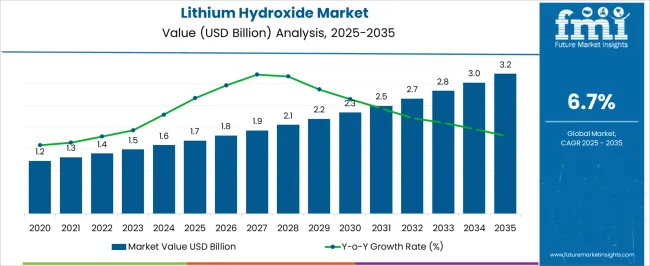
| Metric | Value |
|---|---|
| Lithium Hydroxide Market Estimated Value in (2025 E) | USD 1.7 billion |
| Lithium Hydroxide Market Forecast Value in (2035 F) | USD 3.2 billion |
| Forecast CAGR (2025 to 2035) | 6.7% |
The Lithium Hydroxide market is experiencing robust growth, driven by the rising demand for high-performance lithium-ion batteries in electric vehicles, energy storage systems, and consumer electronics. The increasing global emphasis on clean energy transition and reduction of carbon emissions is accelerating adoption, particularly in regions investing heavily in electric mobility infrastructure. Growth is also being supported by advancements in battery technology, including higher energy density and longer cycle life, which require high-purity lithium hydroxide.
Manufacturers are focusing on optimizing production processes, ensuring consistent quality and compliance with industry standards to meet the stringent requirements of battery-grade applications. Expanding renewable energy projects, coupled with government incentives for electrification and decarbonization, are further boosting demand.
As downstream industries continue to adopt lithium-ion batteries and prioritize sustainable energy solutions, the market for lithium hydroxide is expected to grow steadily Rising investments in mining, processing, and global supply chain expansion are enabling manufacturers to meet increasing demand while maintaining consistent product quality and operational efficiency.
The lithium hydroxide market is segmented by purity type, form, packaging type, application, end-use, and geographic regions. By purity type, lithium hydroxide market is divided into 0.993, 0.99, 0.55, and Others. In terms of form, lithium hydroxide market is classified into Anhydrous and Monohydrate. Based on packaging type, lithium hydroxide market is segmented into Bags, Bottles, and Others. By application, lithium hydroxide market is segmented into Lithium Batteries, Lubricating Grease, Glass And Ceramics, Dye, Carbon Dioxide Scrubbers, and Others. By end-use, lithium hydroxide market is segmented into Transportation, Electronic Devices, Nuclear, Chemical, Metallurgy, and Others. Regionally, the lithium hydroxide industry is classified into North America, Latin America, Western Europe, Eastern Europe, Balkan & Baltic Countries, Russia & Belarus, Central Asia, East Asia, South Asia & Pacific, and the Middle East & Africa.
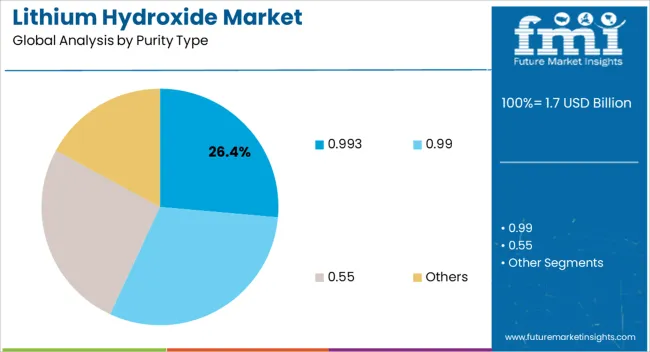
The 99.3% purity type segment is projected to hold 26.4% of the market revenue in 2025, establishing it as the leading purity grade. Growth in this segment is being driven by its suitability for high-performance lithium-ion battery applications, where low impurity levels are critical for consistent electrochemical performance and long cycle life. This purity level enables manufacturers to meet stringent quality standards for battery cathode materials and energy storage systems.
The segment is further supported by increasing adoption in electric vehicles, renewable energy storage, and consumer electronics, where performance consistency and safety are paramount. The ability to maintain high-purity levels through optimized production and quality control processes strengthens its market position.
Manufacturers benefit from reduced degradation rates and improved battery efficiency when utilizing 99.3% purity lithium hydroxide, reinforcing its demand As the global push for energy storage and electrification continues, this purity segment is expected to remain a preferred choice among battery producers, supported by technological advancements, consistent product quality, and increasing demand for high-performance energy storage solutions.
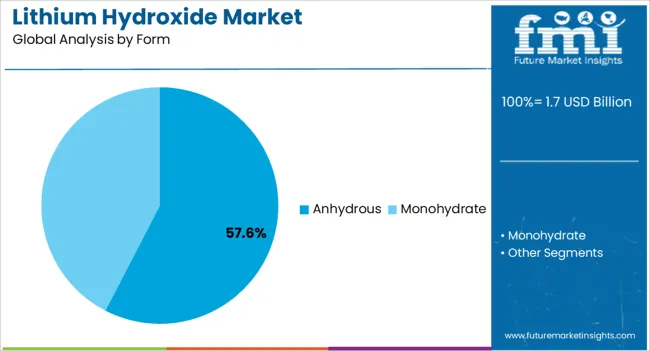
The anhydrous form segment is anticipated to account for 57.6% of the market revenue in 2025, making it the leading form in the lithium hydroxide market. Its growth is being driven by its high reactivity and stability, which are critical for use in cathode material production and other industrial applications. Anhydrous lithium hydroxide provides superior processing efficiency in high-performance battery manufacturing compared with other forms.
Its compatibility with energy storage, electric vehicle battery, and industrial chemical applications has further strengthened adoption. Manufacturers benefit from reduced moisture-related degradation and enhanced shelf life, making it ideal for large-scale industrial usage.
Increasing demand for lithium-ion batteries with high energy density, coupled with the growing need for reliable and efficient production processes, is supporting the segment’s growth As the global transition toward electrification and renewable energy accelerates, the anhydrous form is expected to maintain its leading position, driven by performance advantages, operational efficiency, and widespread adoption in battery and industrial applications.
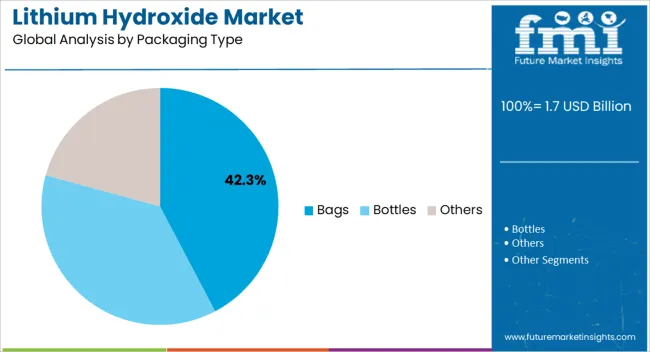
The bags packaging type segment is projected to hold 42.3% of the market revenue in 2025, establishing it as the leading packaging category. Growth in this segment is being driven by the ease of handling, storage, and transportation it provides for lithium hydroxide, particularly in industrial and battery manufacturing settings.
Bag packaging ensures controlled quantities, reduces contamination risk, and facilitates efficient supply chain management. It is also favored for its adaptability in varying production scales, supporting both small- and large-scale battery and chemical applications.
The segment’s growth is further supported by demand from manufacturers seeking standardized, cost-effective, and safe packaging solutions for bulk and intermediate storage As the lithium hydroxide market expands in line with rising demand for energy storage, electric vehicles, and renewable energy projects, the bags packaging segment is expected to maintain its market leadership, driven by operational efficiency, regulatory compliance, and widespread acceptance across production and logistics processes.
The lithium hydroxide market plays a pivotal role in the global transition towards sustainable energy solutions, primarily driven by the burgeoning demand for electric vehicles (EVs) and renewable energy storage systems. As a critical component in the production of lithium-ion batteries, lithium hydroxide serves as a key enabler of this shift.
With the automotive industry increasingly embracing electrification to reduce carbon emissions, the demand for lithium hydroxide is experiencing exponential growth. Additionally, the integration of renewable energy sources like solar and wind necessitates efficient energy storage solutions, further propelling the demand for lithium hydroxide-based batteries.
Geopolitical dynamics, technological advancements, and environmental concerns significantly influence the lithium hydroxide market. Concentrated lithium reserves in countries like Australia, Chile, and China, coupled with supply chain vulnerabilities, highlight geopolitical risks. Technological innovations aimed at enhancing battery performance and sustainability continuously reshape market dynamics, while environmental considerations prompt stakeholders to adopt responsible sourcing practices and invest in cleaner production methods.
Despite its promising outlook, the lithium hydroxide market faces challenges such as supply chain disruptions, production costs, and competitive pressures from alternative battery chemistries. However, strategic investments in production capacity, research and development, and regulatory compliance are expected to address these challenges and foster market resilience.
In summary, the lithium hydroxide industry stands at the forefront of the global energy transition, driven by the imperative to decarbonize transportation and achieve a more sustainable energy ecosystem.
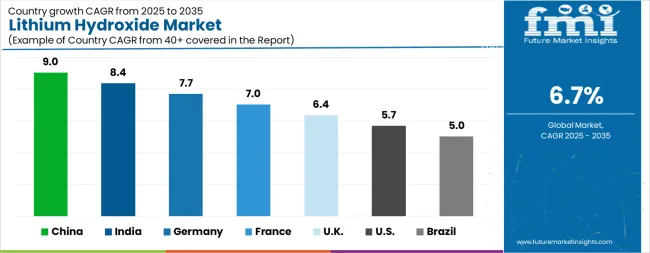
| Country | CAGR |
|---|---|
| China | 9.0% |
| India | 8.4% |
| Germany | 7.7% |
| France | 7.0% |
| UK | 6.4% |
| USA | 5.7% |
| Brazil | 5.0% |
The Lithium Hydroxide Market is expected to register a CAGR of 6.7% during the forecast period, exhibiting varied country level momentum. China leads with the highest CAGR of 9.0%, followed by India at 8.4%. Developed markets such as Germany, France, and the UK continue to expand steadily, while the USA is likely to grow at consistent rates. Brazil posts the lowest CAGR at 5.0%, yet still underscores a broadly positive trajectory for the global Lithium Hydroxide Market. In 2024, Germany held a dominant revenue in the Western Europe market and is expected to grow with a CAGR of 7.7%. The USA Lithium Hydroxide Market is estimated to be valued at USD 580.2 million in 2025 and is anticipated to reach a valuation of USD 1.0 billion by 2035. Sales are projected to rise at a CAGR of 5.7% over the forecast period between 2025 and 2035. While Japan and South Korea markets are estimated to be valued at USD 81.1 million and USD 54.8 million respectively in 2025.
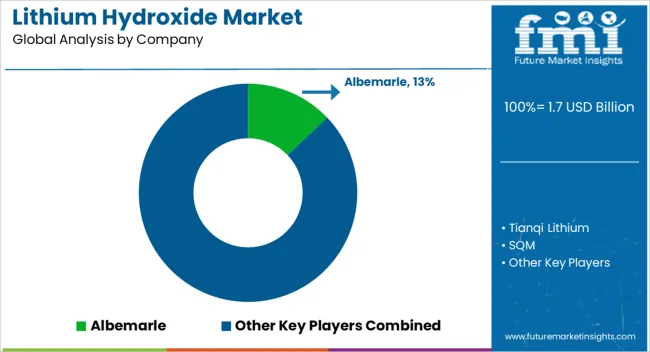
| Item | Value |
|---|---|
| Quantitative Units | USD 1.7 Billion |
| Purity Type | 0.993, 0.99, 0.55, and Others |
| Form | Anhydrous and Monohydrate |
| Packaging Type | Bags, Bottles, and Others |
| Application | Lithium Batteries, Lubricating Grease, Glass And Ceramics, Dye, Carbon Dioxide Scrubbers, and Others |
| End-Use | Transportation, Electronic Devices, Nuclear, Chemical, Metallurgy, and Others |
| Regions Covered | North America, Europe, Asia-Pacific, Latin America, Middle East & Africa |
| Country Covered | United States, Canada, Germany, France, United Kingdom, China, Japan, India, Brazil, South Africa |
| Key Companies Profiled | Albemarle, Tianqi Lithium, SQM, Ganfeng Lithium, Livent, Pilbara Minerals, Galaxy Resources, Cosmos Development Corporation, Lithium Americas, Koch Industries, Nemaska Lithium, Orocobre, Infinity Lithium, Avalon Advanced Materials, and American Battery Technology Company |
The global lithium hydroxide market is estimated to be valued at USD 1.7 billion in 2025.
The market size for the lithium hydroxide market is projected to reach USD 3.2 billion by 2035.
The lithium hydroxide market is expected to grow at a 6.7% CAGR between 2025 and 2035.
The key product types in lithium hydroxide market are 0.993, 0.99, 0.55 and others.
In terms of form, anhydrous segment to command 57.6% share in the lithium hydroxide market in 2025.






Our Research Products

The "Full Research Suite" delivers actionable market intel, deep dives on markets or technologies, so clients act faster, cut risk, and unlock growth.

The Leaderboard benchmarks and ranks top vendors, classifying them as Established Leaders, Leading Challengers, or Disruptors & Challengers.

Locates where complements amplify value and substitutes erode it, forecasting net impact by horizon

We deliver granular, decision-grade intel: market sizing, 5-year forecasts, pricing, adoption, usage, revenue, and operational KPIs—plus competitor tracking, regulation, and value chains—across 60 countries broadly.

Spot the shifts before they hit your P&L. We track inflection points, adoption curves, pricing moves, and ecosystem plays to show where demand is heading, why it is changing, and what to do next across high-growth markets and disruptive tech

Real-time reads of user behavior. We track shifting priorities, perceptions of today’s and next-gen services, and provider experience, then pace how fast tech moves from trial to adoption, blending buyer, consumer, and channel inputs with social signals (#WhySwitch, #UX).

Partner with our analyst team to build a custom report designed around your business priorities. From analysing market trends to assessing competitors or crafting bespoke datasets, we tailor insights to your needs.
Supplier Intelligence
Discovery & Profiling
Capacity & Footprint
Performance & Risk
Compliance & Governance
Commercial Readiness
Who Supplies Whom
Scorecards & Shortlists
Playbooks & Docs
Category Intelligence
Definition & Scope
Demand & Use Cases
Cost Drivers
Market Structure
Supply Chain Map
Trade & Policy
Operating Norms
Deliverables
Buyer Intelligence
Account Basics
Spend & Scope
Procurement Model
Vendor Requirements
Terms & Policies
Entry Strategy
Pain Points & Triggers
Outputs
Pricing Analysis
Benchmarks
Trends
Should-Cost
Indexation
Landed Cost
Commercial Terms
Deliverables
Brand Analysis
Positioning & Value Prop
Share & Presence
Customer Evidence
Go-to-Market
Digital & Reputation
Compliance & Trust
KPIs & Gaps
Outputs
Full Research Suite comprises of:
Market outlook & trends analysis
Interviews & case studies
Strategic recommendations
Vendor profiles & capabilities analysis
5-year forecasts
8 regions and 60+ country-level data splits
Market segment data splits
12 months of continuous data updates
DELIVERED AS:
PDF EXCEL ONLINE
Lithium Battery Thermal Runaway Sensor Modules Market Size and Share Forecast Outlook 2025 to 2035
Lithium Compound Market Forecast Outlook 2025 to 2035
Lithium Silicon Battery Market Size and Share Forecast Outlook 2025 to 2035
Lithium Mining Market Size and Share Forecast Outlook 2025 to 2035
Lithium & Lithium-ion Battery Electrolyte Market Size and Share Forecast Outlook 2025 to 2035
Lithium Battery Shear Wrenches Market Size and Share Forecast Outlook 2025 to 2035
Lithium-sulfur Solid-state Batteries Market Size and Share Forecast Outlook 2025 to 2035
Lithium Extraction From Brine Technology Market Size and Share Forecast Outlook 2025 to 2035
Lithium Cobalt Oxide Market Size and Share Forecast Outlook 2025 to 2035
Lithium Iron Phosphate Market Size and Share Forecast Outlook 2025 to 2035
Lithium Iron Phosphate (LIP) Battery Market Size and Share Forecast Outlook 2025 to 2035
Lithium-Ion Battery Market Size and Share Forecast Outlook 2025 to 2035
Lithium ion Stationary Battery Storage Market Size and Share Forecast Outlook 2025 to 2035
Lithium and Lithium Ion Battery Electrolyte Market Analysis - Size, Share, and Forecast Outlook 2025 to 2035
Lithium Ion Residential Solar Energy Storage Market Size and Share Forecast Outlook 2025 to 2035
Lithium Ion Battery Separator Market Growth & Trends 2025 to 2035
Lithium Ion Battery Dispersant Market Growth – Trends & Forecast 2024-2034
Lithium Ion Battery Material Market Growth – Trends & Forecast 2024-2034
Lithium Iodide Market
Lithium Bromide Market

Thank you!
You will receive an email from our Business Development Manager. Please be sure to check your SPAM/JUNK folder too.
Chat With
MaRIA